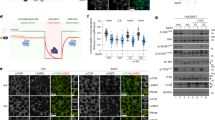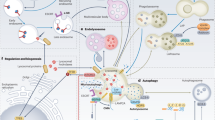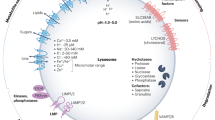Abstract
Lysosome is a key subcellular organelle in the execution of the autophagic process and at present little is known whether lysosomal function is controlled in the process of autophagy. In this study, we first found that suppression of mammalian target of rapamycin (mTOR) activity by starvation or two mTOR catalytic inhibitors (PP242 and Torin1), but not by an allosteric inhibitor (rapamycin), leads to activation of lysosomal function. Second, we provided evidence that activation of lysosomal function is associated with the suppression of mTOR complex 1 (mTORC1), but not mTORC2, and the mTORC1 localization to lysosomes is not directly correlated to its regulatory role in lysosomal function. Third, we examined the involvement of transcription factor EB (TFEB) and demonstrated that TFEB activation following mTORC1 suppression is necessary but not sufficient for lysosomal activation. Finally, Atg5 or Atg7 deletion or blockage of the autophagosome-lysosome fusion process effectively diminished lysosomal activation, suggesting that lysosomal activation occurring in the course of autophagy is dependent on autophagosome-lysosome fusion. Taken together, this study demonstrates that in the course of autophagy, lysosomal function is upregulated via a dual mechanism involving mTORC1 suppression and autophagosome-lysosome fusion.
Similar content being viewed by others
Log in or create a free account to read this content
Gain free access to this article, as well as selected content from this journal and more on nature.com
or
References
Mehrpour M, Esclatine A, Beau I, Codogno P . Autophagy in health and disease. 1. Regulation and significance of autophagy: an overview. Am J Physiol Cell Physiol 2010; 298:C776–C785.
Mizushima N, Komatsu M . Autophagy: renovation of cells and tissues. Cell 2011; 147:728–741.
Yang Z, Klionsky DJ . Mammalian autophagy: core molecular machinery and signaling regulation. Curr Opin Cell Biol 2010; 22:124–131.
Singh R, Cuervo AM . Autophagy in the cellular energetic balance. Cell Metab 2011; 13:495–504.
Rubinsztein DC, Shpilka T, Elazar Z . Mechanisms of autophagosome biogenesis. Curr Biol 2012; 22:R29–R34.
Saftig P, Klumperman J . Lysosome biogenesis and lysosomal membrane proteins: trafficking meets function. Nat Rev Mol Cell Biol 2009; 10:623–635.
Luzio JP, Pryor PR, Bright NA . Lysosomes: fusion and function. Nat Rev Mol Cell Biol 2007; 8:622–632.
Lubke T, Lobel P, Sleat DE . Proteomics of the lysosome. Biochim Biophys Acta 2009; 1793:625–635.
Mindell JA . Lysosomal acidification mechanisms. Annu Rev Physiol 2012; 74:69–86.
Settembre C, Di Malta C, Polito VA, et al. TFEB links autophagy to lysosomal biogenesis. Science 2011; 332:1429–1433.
Sardiello M, Palmieri M, di Ronza A, et al. A gene network regulating lysosomal biogenesis and function. Science 2009; 325:473–477.
Mizushima N, Ohsumi Y, Yoshimori T . Autophagosome formation in mammalian cells. Cell Struct Funct 2002; 27:421–429.
Klionsky DJ, Abeliovich H, Agostinis P, et al. Guidelines for the use and interpretation of assays for monitoring autophagy in higher eukaryotes. Autophagy 2008; 4:151–175.
Scott RC, Schuldiner O, Neufeld TP . Role and regulation of starvation-induced autophagy in the Drosophila fat body. Dev Cell 2004; 7:167–178.
Yoon J, Chang ST, Park JS, Kim YH, Min J . Functional characterization of starvation-induced lysosomal activity in Saccharomyces cerevisiae. Appl Microbiol Biotechnol 2010; 88:283–289.
Thoreen CC, Kang SA, Chang JW, et al. An ATP-competitive mammalian target of rapamycin inhibitor reveals rapamycin-resistant functions of mTORC1. J Biol Chem 2009; 284:8023–8032.
Feldman ME, Apsel B, Uotila A, et al. Active-site inhibitors of mTOR target rapamycin-resistant outputs of mTORC1 and mTORC2. PLoS Biol 2009; 7:e38.
Solomon VR, Lee H . Chloroquine and its analogs: a new promise of an old drug for effective and safe cancer therapies. Eur J Pharmacol 2009; 625:220–233.
Las G, Serada SB, Wikstrom JD, Twig G, Shirihai OS . Fatty acids suppress autophagic turnover in beta-cells. J Biol Chem 2011; 286:42534–42544.
Nyfeler B, Bergman P, Triantafellow E, et al. Relieving autophagy and 4EBP1 from rapamycin resistance. Mol Cell Biol 2011; 31:2867–2876.
Yamamoto A, Tagawa Y, Yoshimori T, Moriyama Y, Masaki R, Tashiro Y . Bafilomycin A1 prevents maturation of autophagic vacuoles by inhibiting fusion between autophagosomes and lysosomes in rat hepatoma cell line, H-4-II-E cells. Cell Struct Funct 1998; 23:33–42.
Bauvy C, Meijer AJ, Codogno P . Assaying of autophagic protein degradation. Methods Enzymol 2009; 452:47–61.
Kwiatkowski DJ . Rhebbing up mTOR: new insights on TSC1 and TSC2, and the pathogenesis of tuberous sclerosis. Cancer Biol Ther 2003; 2:471–476.
Huang J, Dibble CC, Matsuzaki M, Manning BD . The TSC1-TSC2 complex is required for proper activation of mTOR complex 2. Mol Cell Biol 2008; 28:4104–4115.
Jacinto E, Facchinetti V, Liu D, et al. SIN1/MIP1 maintains rictor-mTOR complex integrity and regulates Akt phosphorylation and substrate specificity. Cell 2006; 127:125–137.
Price DJ, Nemenoff RA, Avruch J . Purification of a hepatic S6 kinase from cycloheximide-treated rats. J Biol Chem 1989; 264:13825–13833.
Sarkar S, Davies JE, Huang Z, Tunnacliffe A, Rubinsztein DC . Trehalose, a novel mTOR-independent autophagy enhancer, accelerates the clearance of mutant huntingtin and alpha-synuclein. J Biol Chem 2007; 282:5641–5652.
Sancak Y, Bar-Peled L, Zoncu R, Markhard AL, Nada S, Sabatini DM . Ragulator-Rag complex targets mTORC1 to the lysosomal surface and is necessary for its activation by amino acids. Cell 2010; 141:290–303.
Ohsaki Y, Suzuki M, Shinohara Y, Fujimoto T . Lysosomal accumulation of mTOR is enhanced by rapamycin. Histochem Cell Biol 2010; 134:537–544.
Settembre C, Zoncu R, Medina DL, et al. A lysosome-to-nucleus signalling mechanism senses and regulates the lysosome via mTOR and TFEB. Embo J 2012.
Mizushima N, Yamamoto A, Hatano M, et al. Dissection of autophagosome formation using Apg5-deficient mouse embryonic stem cells. J Cell Biol 2001; 152:657–668.
Komatsu M, Waguri S, Ueno T, et al. Impairment of starvation-induced and constitutive autophagy in Atg7-deficient mice. J Cell Biol 2005; 169:425–434.
Hosokawa N, Hara Y, Mizushima N . Generation of cell lines with tetracycline-regulated autophagy and a role for autophagy in controlling cell size. FEBS Lett 2006; 580:2623–2629.
Martina JA, Chen Y, Gucek M, Puertollano R . MTORC1 functions as a transcriptional regulator of autophagy by preventing nuclear transport of TFEB. Autophagy 2012; 8:903–914.
Jager S, Bucci C, Tanida I, et al. Role for Rab7 in maturation of late autophagic vacuoles. J Cell Sci 2004; 117:4837–4848.
Gutierrez MG, Munafo DB, Beron W, Colombo MI . Rab7 is required for the normal progression of the autophagic pathway in mammalian cells. J Cell Sci 2004; 117:2687–2697.
Kochl R, Hu XW, Chan EY, Tooze SA . Microtubules facilitate autophagosome formation and fusion of autophagosomes with endosomes. Traffic 2006; 7:129–145.
Ganley IG, Wong PM, Gammoh N, Jiang X . Distinct autophagosomal-lysosomal fusion mechanism revealed by thapsigargin-induced autophagy arrest. Mol Cell 2011; 42:731–743.
Zoncu R, Bar-Peled L, Efeyan A, Wang S, Sancak Y, Sabatini DM . mTORC1 senses lysosomal amino acids through an inside-out mechanism that requires the vacuolar H-ATPase. Science 2011; 334:678–683.
Korolchuk VI, Saiki S, Lichtenberg M, et al. Lysosomal positioning coordinates cellular nutrient responses. Nat Cell Biol 2011.
Yu L, McPhee CK, Zheng L, et al. Termination of autophagy and reformation of lysosomes regulated by mTOR. Nature 2010; 465:942–946.
Mizushima N . The role of the Atg1/ULK1 complex in autophagy regulation. Curr Opin Cell Biol 2010; 22:132–139.
Henne WM, Buchkovich NJ, Emr SD . The ESCRT pathway. Dev Cell 2011; 21:77–91.
Ravikumar B, Acevedo-Arozena A, Imarisio S, et al. Dynein mutations impair autophagic clearance of aggregate-prone proteins. Nat Genet 2005; 37:771–776.
Fraldi A, Annunziata F, Lombardi A, et al. Lysosomal fusion and SNARE function are impaired by cholesterol accumulation in lysosomal storage disorders. EMBO J 2010; 29:3607–3620.
Williamson WR, Wang D, Haberman AS, Hiesinger PR . A dual function of V0-ATPase a1 provides an endolysosomal degradation mechanism in Drosophila melanogaster photoreceptors. J Cell Biol 2010; 189:885–899.
Berg TO, Fengsrud M, Stromhaug PE, Berg T, Seglen PO . Isolation and characterization of rat liver amphisomes. Evidence for fusion of autophagosomes with both early and late endosomes. J Biol Chem 1998; 273:21883–21892.
Thoene JG, Lemons R, Boskovich S, Borysko K . Inhibitors of protein synthesis also inhibit lysosomal proteolysis. Studies using cystinotic fibroblasts. J Clin Invest 1985; 75:370–376.
Dancey JE, Curiel R, Purvis J . Evaluating temsirolimus activity in multiple tumors: a review of clinical trials. Semin Oncol 2009; 36 Suppl 3:S46–S58.
Konings IR, Verweij J, Wiemer EA, Sleijfer S . The applicability of mTOR inhibition in solid tumors. Curr Cancer Drug Targets 2009; 9:439–450.
Zask A, Verheijen JC, Richard DJ . Recent advances in the discovery of small-molecule ATP competitive mTOR inhibitors: a patent review. Expert Opin Ther Pat 2011; 21:1109–1127.
Zhang YJ, Duan Y, Zheng XF . Targeting the mTOR kinase domain: the second generation of mTOR inhibitors. Drug Discov Today 2011; 16:325–331.
Kallunki T, Olsen OD, Jaattela M . Cancer-associated lysosomal changes: friends or foes? Oncogene 2012 Jul 9. doi:10.1038/onc.2012.292
Kuma A, Hatano M, Matsui M, et al. The role of autophagy during the early neonatal starvation period. Nature 2004; 432:1032–1036.
Zhang H, Cicchetti G, Onda H, et al. Loss of Tsc1/Tsc2 activates mTOR and disrupts PI3K-Akt signaling through downregulation of PDGFR. J Clin Invest 2003; 112:1223–1233.
Ni HM, Bockus A, Wozniak AL, et al. Dissecting the dynamic turnover of GFP-LC3 in the autolysosome. Autophagy 2011; 7:188–204.
Wu YT, Tan HL, Huang Q, et al. Autophagy plays a protective role during zVAD-induced necrotic cell death. Autophagy 2008; 4:457–466.
Zhou J, Hu SE, Tan SH, et al. Andrographolide sensitizes cisplatin-induced apoptosis via suppression of autophagosome-lysosome fusion in human cancer cells. Autophagy 2012; 8:338–349.
Acknowledgements
We thank Dr N Mizushima (Tokyo Medical and Dental University, Japan) for providing the Atg5−/− MEFs and the Tet-off Atg5 MEFs with stable expression of GFP-LC3, as well as the HeLa cells with stable expression of GFP-LC3, Dr A Ballabio (Telethon Institute of Genetics and Medicine, Italy) for providing the Flag-TFEB expression vector and the TFEB-luciferase construct, Dr DJ Kwiatkowski (Harvard University, USA) for providing the pair of TSC2 WT and KO MEFs, and Dr DM Sabatini (Massachusetts Institute of Technology, USA) for providing Torin1. We also thank Dr N Mizushima and Dr WX Ding for the insightful discussions. SHT, NDY and JZ were supported by research scholarships from NUS. This study was supported in part by research grants from Singapore National Medical Research Council (NMRC/1260/2010), Singapore Biomedical Research Council (BMRC /08/1/21/19/554) to HMS and by INSERM grants to PC.
Author information
Authors and Affiliations
Corresponding author
Additional information
( Supplementary information is linked to the online version of the paper on the Cell Research website.)
Supplementary information
Supplementary information, Figure S1
Induction of autophagy by starvation and mTOR inhibitors in HeLa cells. (PDF 591 kb)
Supplementary information, Figure S2
PP242 and Torin1, but not rapamycin enhance cathepsin activity. (PDF 218 kb)
Supplementary information, Figure S3
Effects of Starvation, PP242, Torin1 and rapamycin on lysosomal function in HeLa cells. (PDF 326 kb)
Supplementary information, Figure S4
Effects of starvation, PP242 and rapamycin on lysosome in Sin1-WT and KO MEFs. (PDF 255 kb)
Supplementary information, Figure S5
Effects of Trehalose on mTORC1 activity and lysosomal function. (PDF 400 kb)
Supplementary information, Figure S6
Changes of LysoTracker staining in Atg5-deficient cells. (PDF 682 kb)
Supplementary information, Figure S7
Lysosomal activation induced by starvation or mTOR inhibitors in primary Atg5 WT/KO MEFs and Atg7 WT/KO MEFs. (PDF 531 kb)
Rights and permissions
About this article
Cite this article
Zhou, J., Tan, SH., Nicolas, V. et al. Activation of lysosomal function in the course of autophagy via mTORC1 suppression and autophagosome-lysosome fusion. Cell Res 23, 508–523 (2013). https://doi.org/10.1038/cr.2013.11
Received:
Revised:
Accepted:
Published:
Issue date:
DOI: https://doi.org/10.1038/cr.2013.11
Keywords
This article is cited by
-
Arsenic trioxide: applications, mechanisms of action, toxicity and rescue strategies to date
Archives of Pharmacal Research (2024)
-
Intermittent hypoxia therapy ameliorates beta-amyloid pathology via TFEB-mediated autophagy in murine Alzheimer's disease
Journal of Neuroinflammation (2023)
-
Induction of lysosomal exocytosis and biogenesis via TRPML1 activation for the treatment of uranium-induced nephrotoxicity
Nature Communications (2023)
-
Lysosomal dysfunction in Schwann cells is involved in bortezomib-induced peripheral neurotoxicity
Archives of Toxicology (2023)
-
Intracellular cholesterol transport inhibition Impairs autophagy flux by decreasing autophagosome–lysosome fusion
Cell Communication and Signaling (2022)



